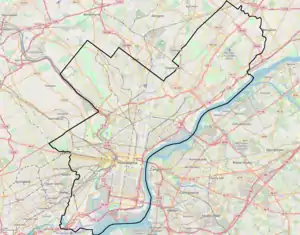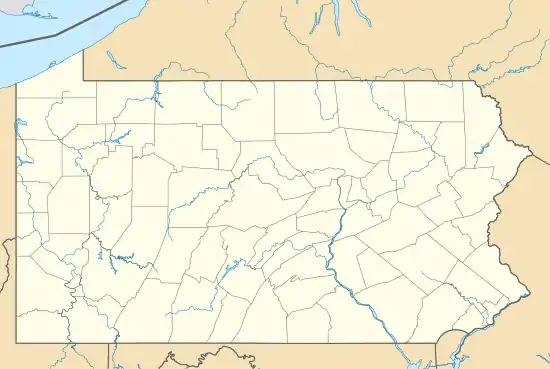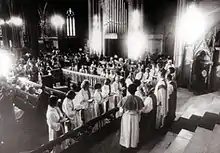George W. South Memorial Protestant Episcopal Church of the Advocate | |
 | |
   | |
| Location | 18th & Diamond Sts. Philadelphia, Pennsylvania |
|---|---|
| Coordinates | 39°59′9″N 75°9′49″W / 39.98583°N 75.16361°W |
| Built | 1887 |
| Architect | Charles Marquedant Burns; Arthur H. Williams & Sons |
| Architectural style | Gothic Revival |
| NRHP reference No. | 80003620[1] |
| Significant dates | |
| Added to NRHP | February 8, 1980 |
| Designated NHL | June 19, 1996 |
| Designated PHMC | July 29, 1999[2] |

The George W. South Memorial Church of the Advocate, also known as the George W. South Memorial Protestant Episcopal Church, is a historic church at 18th and Diamond Street in North Philadelphia, Pennsylvania, USA.
History
The church was built from 1887 to 1897 as a memorial to the merchant and civil leader George W. South. The church was designed by Charles Marquedant Burns (1838 – 1922), a prominent church architect in the late 19th and early 20th century. It was intended to serve as the Episcopal Cathedral of Philadelphia.[3]
On July 29, 1974, the church was the site of the ordination of the Philadelphia Eleven, the first women priests in the Episcopal Church.[4][5]
The church contains a series of 14 murals[6] depicting vignettes of the Black experience in America, including slavery, emancipation, and scenes from the Civil Rights Movement. They were painted between 1973 and 1976 by Philadelphia artist Walter Edmonds[7] and Richard J. Watson.[8] The murals can be found primarily in the transepts and aisles of the church. Father Washington commissioned the murals in response to black parishioners who felt that the African-American experience was not validated in the church despite the fact that the majority of the community was African-American. Each of the fourteen murals was painted by either Edmonds or Watson, each of whom has a very different artistic style. Edmonds's[9] pieces are mostly in fiery shades of orange and yellow and depict the violent oppression of blacks in America. Watson,[10] on the other hand, used a cooler palette in his paintings to express sorrow in the black experience and the importance of memorializing this history as a way to find courage for the future.
The church was added to the National Register of Historic Places in 1980, and was designated a National Historic Landmark on June 19, 1996. The landmark designation cited the church as one of the finest examples of Gothic Revival architecture, with a complete set of stained glass windows provided by the English firm Clayton & Bell. It also cited the church's ongoing role in activism for African American civil rights.[11]
See also
References
- ↑ "National Register Information System". National Register of Historic Places. National Park Service. January 23, 2007.
- ↑ "PHMC Historical Markers". Historical Marker Database. Pennsylvania Historical & Museum Commission. Archived from the original on December 7, 2013. Retrieved December 10, 2013.
- ↑ Listing Archived 2011-06-06 at the Wayback Machine as a National Historic Landmark at the National Park Service.
- ↑ "Woman in the News: Advocate of Equality, Barbara C. Harris", New York Times, by Peter Steinfels, September 26, 1988.
- ↑ Charles V. Willie, "The Priesthood of All Believers: Sermon preached on the occasion of a Service of Ordination..., July 29, 1974" in Betty Bone Schiess, Why Me Lord?: One Woman's Ordination to the Priesthood with Commentary and Complaint (Syracuse, NY: Syracuse University Press, 2003) pp. 145-152
- ↑ "Paintings on the Bible and the Black Experience". Archived from the original on February 4, 2002. Retrieved December 18, 2009.
- ↑ Naedele, Walter F. (June 18, 2011). "Philadelphia artist Walter Edmonds, 73". Philadelphia Inquirer - Obituaries. The Philadelphia Inquirer, LLC. Retrieved December 28, 2023.
- ↑ Valerio, William R (2015). We speak : black artists in Philadelphia, 1920s–1970s. Philadelphia: Woodmere Art Museum. p. 227. ISBN 9781888008005.
- ↑ "Painting Eleven". Archived from the original on July 23, 2008. Retrieved December 18, 2009.
- ↑ "Painting Ten". Archived from the original on July 23, 2008. Retrieved December 18, 2009.
- ↑ "NHL nomination for Church of the Advocate". National Park Service. Retrieved March 17, 2017.
External links
- Official websiteArchived 13 July 2023
- Church of the Advocate data from the Philadelphia Architects and Buildings (PAB) project of the Athenaeum of Philadelphia
- Historic American Buildings Survey (HABS) No. PA-6672, "Church of the Advocate"

